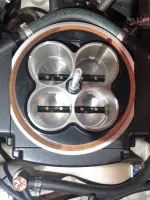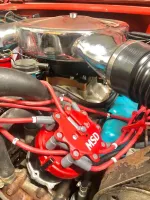Attention Sniper Owners...
007
Crazy Sr. Respected Jeeper
- Posts
- 3,451
- Media
- 5
- Solutions
- 1
- Thanks
- 64
- Location
- Reno, NV
- Vehicle(s)
- 1977 CJ-7 Renegade (Daisy Jane), Levis trim, 304, TH400, BW1339 (MM), D30/Auburn Max, AMC20/Detroit/G2's, 4.88's, 33" BFG MT KM2's, Edelbrock Performer intake, Holley Sniper 4bbl EFI, MSD6, MSD ProBillet distributor, OME shocks, 4" ProComp lift.
Two things I learned recently and really want to share...
Last Sunday I was out wheeling and having a blast. About 2/3 of the way through I developed a miss. I figured it was a plug as I knew my plugs were in need of replacement.
I finished the trail and hobbled home on 7 cylinders and pulled it in the garage and out a fan on it and went straight to the parts store and got plugs. Sure enough, #3 looked A LOT different than the rest. Put them all in, fired it up. I It idled smooth, but as soon as I touched the throttle, the miss came back.
Naturally I thought, well it's gotta be wires then right? Picked up a set of wires at Summit (thank God we have a store here) and replaced #3 - made no difference. So I replaced ALL the wires, no difference.
Pulled off the cap, inspected it, cleaned the contacts with a rotary wire brush, no difference.
Changed tunes on the Sniper to an older one, no difference. Put the current one back.
Finally I got on the Sniper forums on the Holley site and when through all this there, and not long after I got a response that it could be a bad injector OR perhaps just a loose connection on the injector. They said to pull the air cleaner, fire it up and see if all injectors were firing.
I did just that and BAM - the front passenger side injector was dry!

Finally a root cause! So I went back to the forum and reported my findings and asked - what do I do now?
What you do is unscrew whatever side the problem is on and the injectors are housed in those sides. I pulled my passenger side off nervous as can be, and gently snuck a flat head screwdriver inside between the housing and the back of the plug and sort of pried it downward and sure enough it slid down about 1/8". I quickly pulled out the screwdriver, reattached the side and fired it up and voila - problem solved!
I also noticed that this is the injector that would feed the #3 cylinder.

The second thing I learned, I learned by accident in searching for solutions to the first problem. This topic is under some debate, but for me it's a no-brainer. Many (myself included) have found a noticeable improvement in throttle response and performance in raising the throttle body up an inch, particularly on dual-plane intakes like the Edelbrock Performer. Doing so creates the ability for the fuel mixture to flow differently (similar to what you find in open-plenum intakes EDITED due to TeamRush's correction below - which I appreciate!) and perhaps of equal importance, it leaves the MAP sensor completely uncovered and exposed for better metering/measurements.
I added a 1" phenolic spacer to mine and I like the results, plus it will keep the throttle body a tad cooler, and that's always good.

Sent from my iPhone
Last Sunday I was out wheeling and having a blast. About 2/3 of the way through I developed a miss. I figured it was a plug as I knew my plugs were in need of replacement.
I finished the trail and hobbled home on 7 cylinders and pulled it in the garage and out a fan on it and went straight to the parts store and got plugs. Sure enough, #3 looked A LOT different than the rest. Put them all in, fired it up. I It idled smooth, but as soon as I touched the throttle, the miss came back.
Naturally I thought, well it's gotta be wires then right? Picked up a set of wires at Summit (thank God we have a store here) and replaced #3 - made no difference. So I replaced ALL the wires, no difference.
Pulled off the cap, inspected it, cleaned the contacts with a rotary wire brush, no difference.
Changed tunes on the Sniper to an older one, no difference. Put the current one back.
Finally I got on the Sniper forums on the Holley site and when through all this there, and not long after I got a response that it could be a bad injector OR perhaps just a loose connection on the injector. They said to pull the air cleaner, fire it up and see if all injectors were firing.
I did just that and BAM - the front passenger side injector was dry!

Finally a root cause! So I went back to the forum and reported my findings and asked - what do I do now?
What you do is unscrew whatever side the problem is on and the injectors are housed in those sides. I pulled my passenger side off nervous as can be, and gently snuck a flat head screwdriver inside between the housing and the back of the plug and sort of pried it downward and sure enough it slid down about 1/8". I quickly pulled out the screwdriver, reattached the side and fired it up and voila - problem solved!
I also noticed that this is the injector that would feed the #3 cylinder.

The second thing I learned, I learned by accident in searching for solutions to the first problem. This topic is under some debate, but for me it's a no-brainer. Many (myself included) have found a noticeable improvement in throttle response and performance in raising the throttle body up an inch, particularly on dual-plane intakes like the Edelbrock Performer. Doing so creates the ability for the fuel mixture to flow differently (similar to what you find in open-plenum intakes EDITED due to TeamRush's correction below - which I appreciate!) and perhaps of equal importance, it leaves the MAP sensor completely uncovered and exposed for better metering/measurements.
I added a 1" phenolic spacer to mine and I like the results, plus it will keep the throttle body a tad cooler, and that's always good.

Sent from my iPhone
Last edited:

 (composting), pulled stumps & logs, plowed/disked, pulled, pushed and generally did everything I needed to build the homestead from dirt up.
(composting), pulled stumps & logs, plowed/disked, pulled, pushed and generally did everything I needed to build the homestead from dirt up.